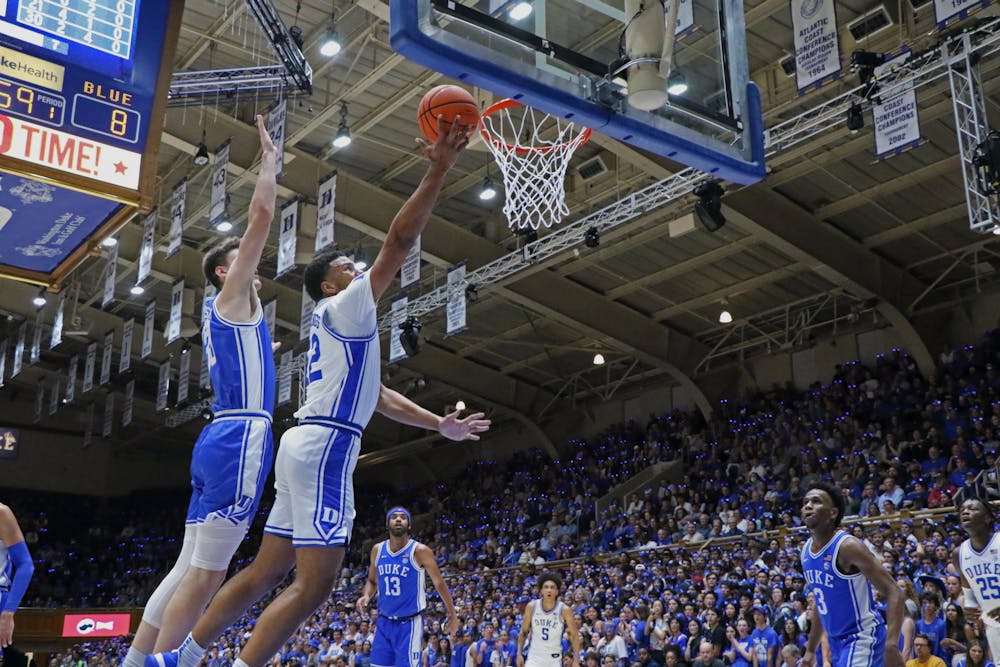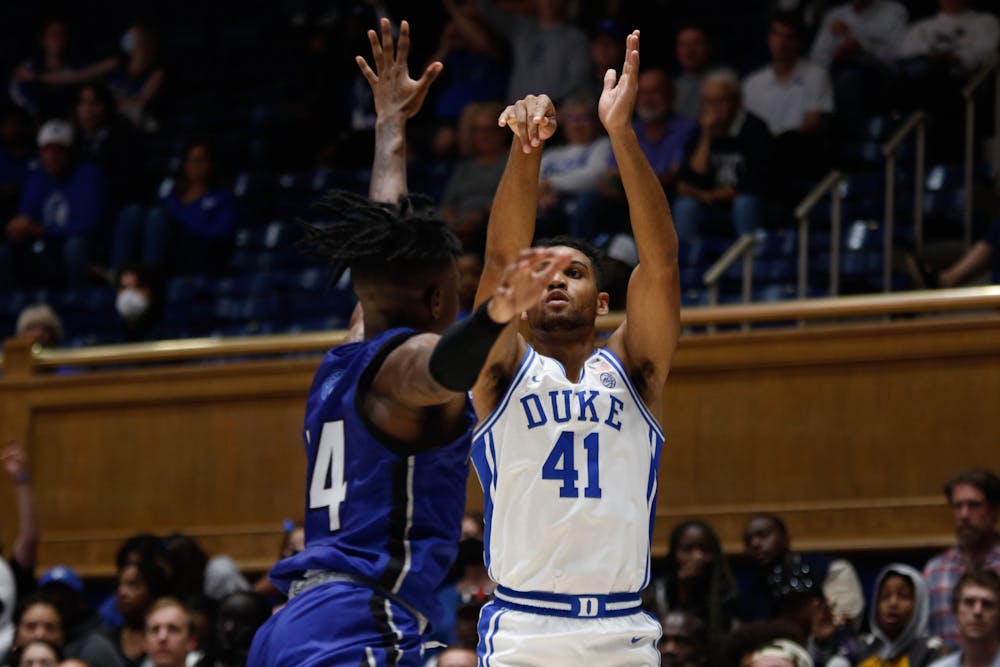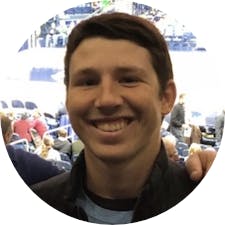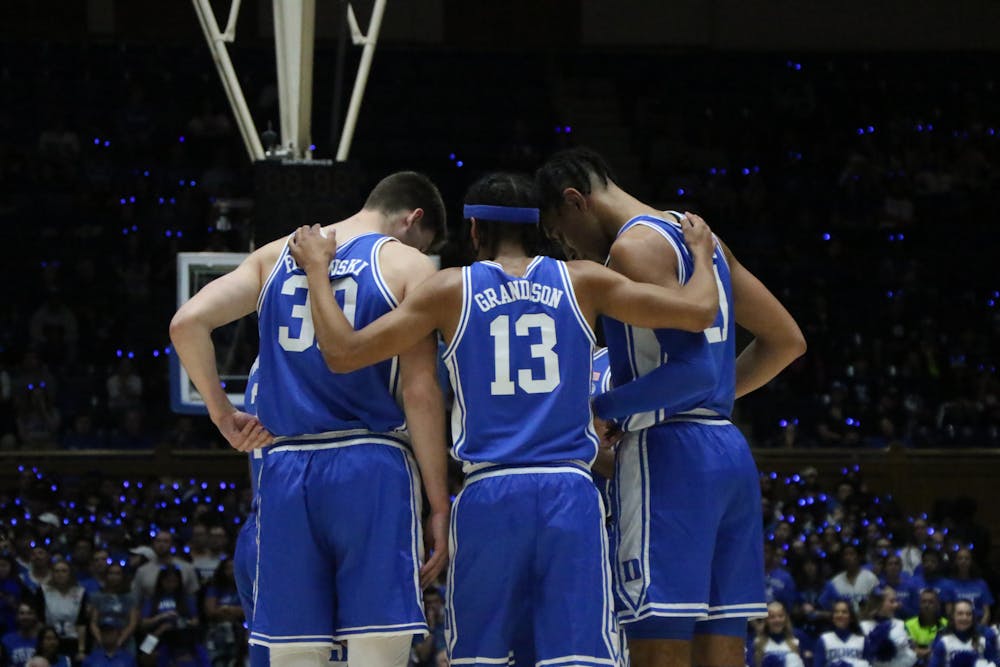For Duke, what’s old is new.
It started with Patrick Tapé in 2020-21, the first graduate transfer of the Mike Krzyzewski era. Now, with new head coach Jon Scheyer at the helm, four graduate transfers—guard Max Johns (Princeton), wings Jacob Grandison (Illinois) and Kale Catchings (Harvard) and center Ryan Young (Northwestern)—have entered the fold.
During the program’s preseason media day Sept. 27, Scheyer was noncommittal about adding graduate transfers down the road, saying “We don’t plan on that being the main way for us to continue to put our roster together.” But the 35-year-old, acknowledging the effect that Theo John and Bates Jones had on the floor a season ago, also noted “We feel Ryan Young and Jacob Grandison will have that same impact on the court for us,” in the upcoming campaign.
Each has taken a unique path to this point, but their goals are the same. To provide depth, college experience and a steady head as Duke, with seven freshmen in the fold, embarks on this new era under Scheyer.
But how, exactly, did they each get here?
‘Changed almost year to year’
For the first time in nearly five years, Northwestern knocked off a top-10 team on the road. In the raucous Breslin Center Jan. 15, the Wildcats outlasted then-No. 10 Michigan State 64-62.
A massive reason for that was Young.
With regular starting center Pete Nance—now set to replace Brady Manek as North Carolina’s starting power forward—out with an ankle injury, Young made his first start of the season that night in East Lansing, Mich. But the then-redshirt junior, thanks to having “accepted being a starter who doesn’t start,” according to Northwestern assistant coach Brian James, was prepared.
In 27 minutes, Young notched 18 points, eight rebounds, two steals, two assists and went 6-of-8 from the charity stripe. After multiple and-ones, the New Jersey native let out a mighty yell, his intensity evident.
“We played tough for 40 minutes, we outrebounded them, we got to the free-throw line more than they did, and yet the best player on the floor was Ryan,” James said.
To get to that point, though, Young took a winding journey. A native of Stewartsville, N.J., an unincorporated community just more than an hour west of New York, Young was a standout at Bethlehem Catholic High School (thirty minutes away from Stewartsville in eastern Pennsylvania) averaging 16.3 points and 12.3 rebounds his senior year as the 2017-18 Golden Hawks reached the state semifinals.
Once Young arrived in Evanston, Ill., to play for former Duke point guard and assistant coach Chris Collins, he got acclimated thanks to a pair of mentors.
“I had two really successful bigs ahead of me, it was a senior, Dererk Pardon and a junior, Barret Benson, when I was a freshman,” Young said of that redshirt season during team media day. “And I came into college, I was not ready to play, I was undersized, I didn’t have the right touch, and I really appreciate [what] those two guys did for me, at such a young age.”
As a redshirt freshman in 2019-20, Young started all 31 games at center and averaged nine points and 6.1 rebounds per contest.
But starting in 2020-21, Collins elected for a small ball starting five, sliding Nance over to center and relegating Young to the bench for all but five games. His minutes (25.7 to 18.9), points (9.0 to 7.8) and rebounds (6.1 to 4.8) all dropped as his Northwestern career transitioned from the developmental stage to the hectic stage.
“It’s changed almost year-to-year for me,” Young said of his role after the Michigan State win.
Despite the performance against Michigan State, Young was once again the backup center three days later against Wisconsin. He ended the year averaging 9.0 points and 4.2 rebounds in just more than 17 minutes per game, and once the season ended, he wanted to spend his remaining two years of eligibility elsewhere.
“I really did love my experience at Northwestern,” Young said at Duke’s media day. “I love the coaching staff and my teammates there, and I love the school. But through four years, we just really didn’t hit the goals that we wanted to in terms of winning and losing.”
After the season ended, Young connected with Scheyer and assistant coach Amile Jefferson, noticing the former’s “passion for coaching and his will to win.” His commitment was secured.
Get The Chronicle straight to your inbox
Sign up for our weekly newsletter. Cancel at any time.
In the same vein that Pardon and Benson helped him as a freshman, Young will be a source of guidance for the younger Blue Devil bigs—Dereck Lively II, Kyle Filipowski and Christian Reeves.
It’s a role that Young is ready for.
“Change is sometimes daunting and scary,” Young said. “But in this instance, and most of the way that I just approach my daily life and life in general, is that change is exciting and good and you can learn about new experiences.”

‘Finding the niche’
Rewind to the 2021 NCAA tournament. Heading into the Big Dance, Illinois was 23-6 (including an 83-68 win against Duke in Cameron Indoor Stadium) and received a No. 1 seed for the first time since 2005.
Much of the buzz for that Illinois group centered around dynamic point guard Ayo Dosunmu and bruising center Kofi Cockburn. But every championship contender needs a supporting cast, and by the end of the year, Grandison, who started his college career at Holy Cross before transferring to Illinois prior to the 2019-20 season, was playing a key role.
Upon entering the starting lineup Jan. 19 against Penn State, Grandison averaged six points, 4.2 rebounds and 1.5 assists while shooting 66.7% from two and 38.5% from three. You might not think six points per game is an overwhelming stat, and in a vacuum, you might be right.
But basketball is more than just takeover scoring. Grandison moves extremely well without the ball, can run the floor and is an active perimeter defender. With the Oakland, Calif., native in the starting lineup, Illinois went 14-2 through its run to the conference tournament title.
That cannot be fully credited to the 6-foot-6 guard, but Scheyer feels that highlights Grandison’s greatest strength.
“His best quality is he’s a winner,” Scheyer said. “He knows how to play the game, and he knows how to make others better. He plays at a great pace, he’s not about himself, he’s not about his statistics.”
Then, there is his ability to shoot the rock. In his final year with the Fighting Illini, Grandison shot 41.1% from downtown on 134 attempts, including 54.8% on 42 corner attempts, according to CBB Analytics. Is he Ray Allen? No, but the 24-year-old will be in the running for best shooter in the rotation, alongside freshman Tyrese Proctor and Filipowski.
In Grandison’s eyes, though, he is more than just a shooter.
“Honestly, I’m a good shooter,” Grandison said. “But that’s kind of a product of what I was doing at Illinois. … So I think I’m pretty good at finding the niche, finding what I need to do to make a team successful and it doesn’t.”
As a defender, Grandison views his versatility as a strength, saying that “I understand how to guard a smaller person, someone my size or someone bigger.”
On his journey to Durham, Grandison has been well-traveled. An Oakland native who played for Team Lillard in AAU, Grandison graduated from high school in the final year of the Obama administration. He then took a post-grad year at Phillips Exeter Academy in New Hampshire, winning MVP of the New England Preparatory School Athletic Council Class A championship after a 20-point display.
Then came Holy Cross, then Illinois—where he received an undergraduate degree in earth, society and environmental sustainability and a graduate degree in business management from the GIES School of Business—with a stint on the Finnish national team (his mother, Carina, is Finnish, and Grandison holds dual citizenship) in an Olympic prep tournament two summers ago sprinkled in.
Now, he is at Duke, a program that is “all about winning” in his eyes. Grandison spent the summer rehabbing a shoulder injury he suffered late last season, but now, he is ready to roll alongside the young guns.
“One of the most relieving things is how much chemistry we actually all have, and I’ve seen so-so chemistry, I’ve seen great chemistry, I’ve seen it all,” Grandison said at ACC Tipoff.

‘Not afraid of the moment’
During a Christmas break practice in the midst of the 2017-18 season, the Liberty High School Eagles were struggling. But it was not head coach William “Chip” Sodemann who got things steered in the right direction.
It was Kale Catchings.
“Kale actually kind of stopped the play himself,” Sodemann told The Chronicle. “And he took over and he very passionately told his teammates that what they were doing just wasn’t going to make us any better, and that they needed to step up their intensity and their physicality in order for us to become a better team.
“And he was absolutely right,” Sodemann said.
Catchings transferred to Liberty High in the St. Louis area after three years at nearby Christian Brothers College High, making the transition from private to public school. Upon his arrival at Liberty High for summer workouts, Catchings’ competitive nature and his “great smile,” in Sodemann’s words, stood out.
“There are guys that are sometimes competitive. And then there are guys that are on the next level, and Kale was an elite competitor. He was not afraid of the moment,” Sodemann said.
Catchings committed to Harvard and head coach Tommy Amaker—another former Duke point guard and assistant—early in the school year, a move that he was excited about, according to Sodemann.
In three seasons at Harvard (the Ivy League canceled all sports during the 2020-21 school year), Catchings averaged 6.5 points and three boards per contest, while shooting better than 47% from the field and 35% from distance. Last year, he set career highs in nearly every major statistical category, and graduated with a degree in economics.
Catchings said his skillset is “very conducive to position-less basketball,” and said he enjoys watching glue guys like Draymond Green and PJ Tucker.
“I think I just could be a spark plug and bring whatever the team is lacking and kind of bring that feistiness,” Catchings said at media day.
Plus, Catchings’ aunt is Tamika Catchings, was a seven-time All-WNBA first teamer, the 2011 WNBA MVP and 2012 WNBA Finals MVP for the title-winning Indiana Fever. Tamika Catchings also overlapped at Tennessee with Duke women’s basketball head coach Kara Lawson.
“Coach Lawson probably remembers holding me as a baby as they competed against one another [in the WNBA] whenever I was younger,” Catchings said at media day. He added that Mike Sotsky, a Harvard assistant, was a Duke manager for the 2015 title team, so he could “see the common threads with Coach Amaker and how he runs his program and some of the traditions here.”
During summers growing up, Catchings would spend a week with his aunt at practice, being able to “see what it was like to be a professional player.” With the Champions Classic against Kansas in Indianapolis, Catchings will be able to see his aunt’s jersey in the rafters, a “full circle moment” for the 23-year-old.
“It’s how our family bonds, I don’t really know anything else,” Catchings said of his family’s basketball focus.

‘Fully looked into my soul, bro’
It was an otherwise ho-hum blowout win against Princeton in December 2018. Duke cruised to a 101-50 drubbing, with Zion Williamson’s remarkable rejection of Jaelin Llewellyn serving as the highlight of the night.
There was also the player who, in four minutes of action for Princeton, attempted a single shot.
That player was Max Johns, who got his degree in neuroscience in May. But it was not the first time he ventured into Cameron Indoor Stadium, as Johns went to the Duke Basketball Camp as an elementary schooler.
While he and some friends were joking around while Krzyzewski gave a speech, the former Duke head coach taught them a lesson.
“He stopped, and he fully looked into my soul, bro,” Johns said on the Go with the Flo podcast in November 2021. “I have never felt so small in my life before, he was like, ‘Lebron doesn’t do this, Kobe would never do this. When I’m talking everybody listens, and you guys are just laughing to the side.’ Bro, that was the scariest moment of my life.”
Johns grew up in nearby High Point, N.C., and his family has roots in North Carolina basketball. His cousin, George Lynch, averaged 14.7 points per game as a member of the Tar Heels’ 1993 national-champion men’s basketball team.
A man whose interests include fashion, chess and skating, per the aforementioned podcast appearance, Johns is unlikely to see the court much as a Blue Devil (he averaged 2.8 points and 1.3 rebounds in 7.4 minutes for the Tigers last year). Upon his commitment in June, however, Scheyer called the 22-year-old a “high-character individual that will add a veteran presence in our locker room,” and someone who will “push our guys on and off the court.”
‘Been through the hardships’
Young, Catchings and Johns are enrolled in the Fuqua School of Business, while Grandison is enrolled in Duke’s continuing studies program. That basketball-academic balance seems to be an enticing one.
None of the four will lead Duke in scoring, and the chatter for Scheyer’s first year is centered around the top-ranked freshman class. But make no mistake about it, these four are set to impact the season.
“They’ve been through the hardships of the college regular season,” point guard Jeremy Roach, the lone Blue Devil captain, said at media day. “So they know that it’s gonna be highs, it’s gonna be lows, but you got to just stay the course.”
Rest assured, the graduate transfers, who live in the same apartment building and go to trivia nights, according to Catchings, are ready to show that old guys still matter in college basketball.
“For us to be able to alleviate some of that [pressure] hopefully, and help guys in the locker room on the court with just kind of those maturity aspects, is definitely a piece that helped me and I think that all that is going to be very conducive to building a new culture and building a new tradition,” Catchings said.
Editor's note: This article is one of many in The Chronicle's men's basketball season preview. Find the rest here.

Max Rego is a Trinity senior and an associate sports editor for The Chronicle's 118th volume. He was previously sports managing editor for Volume 117.

